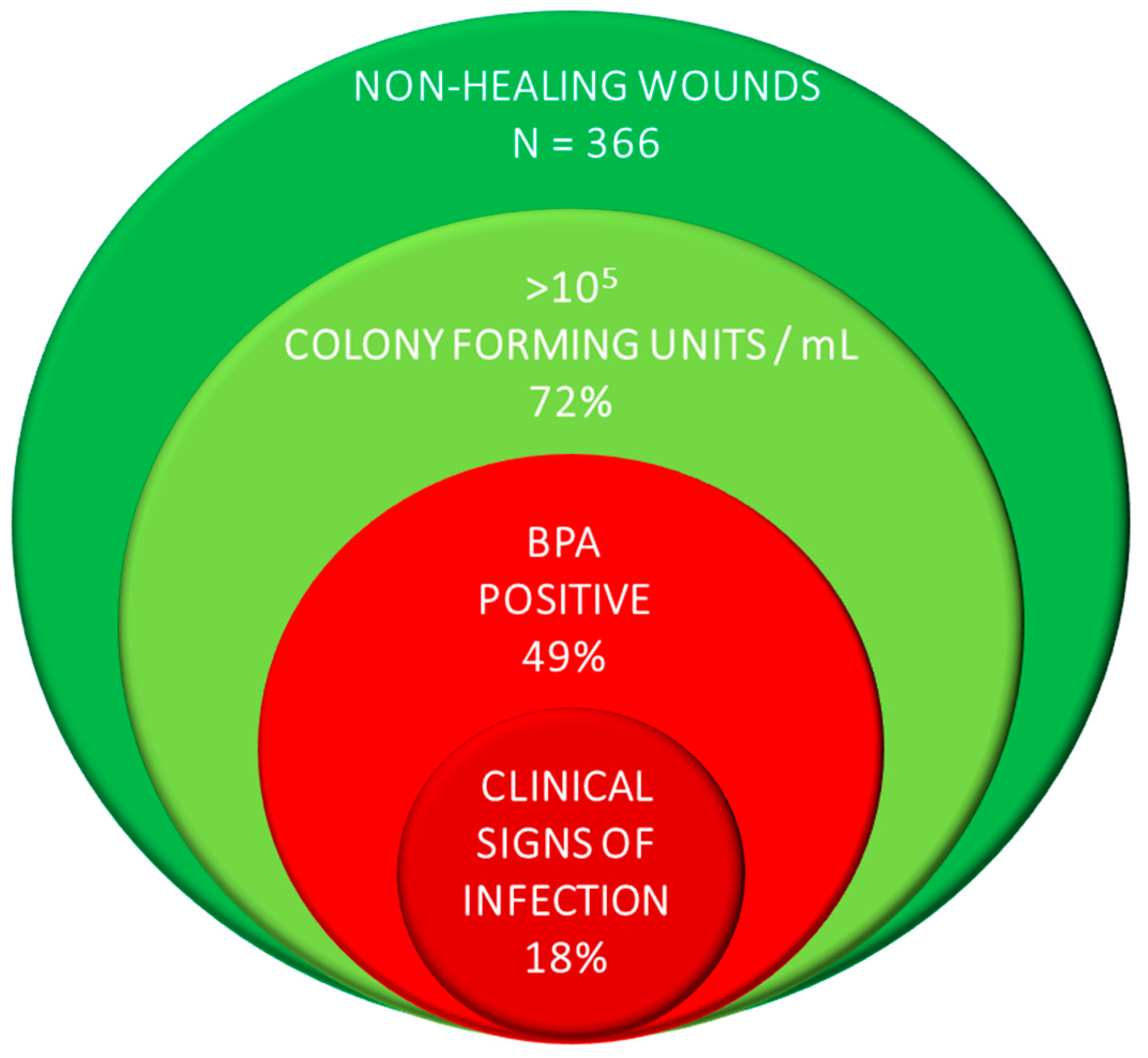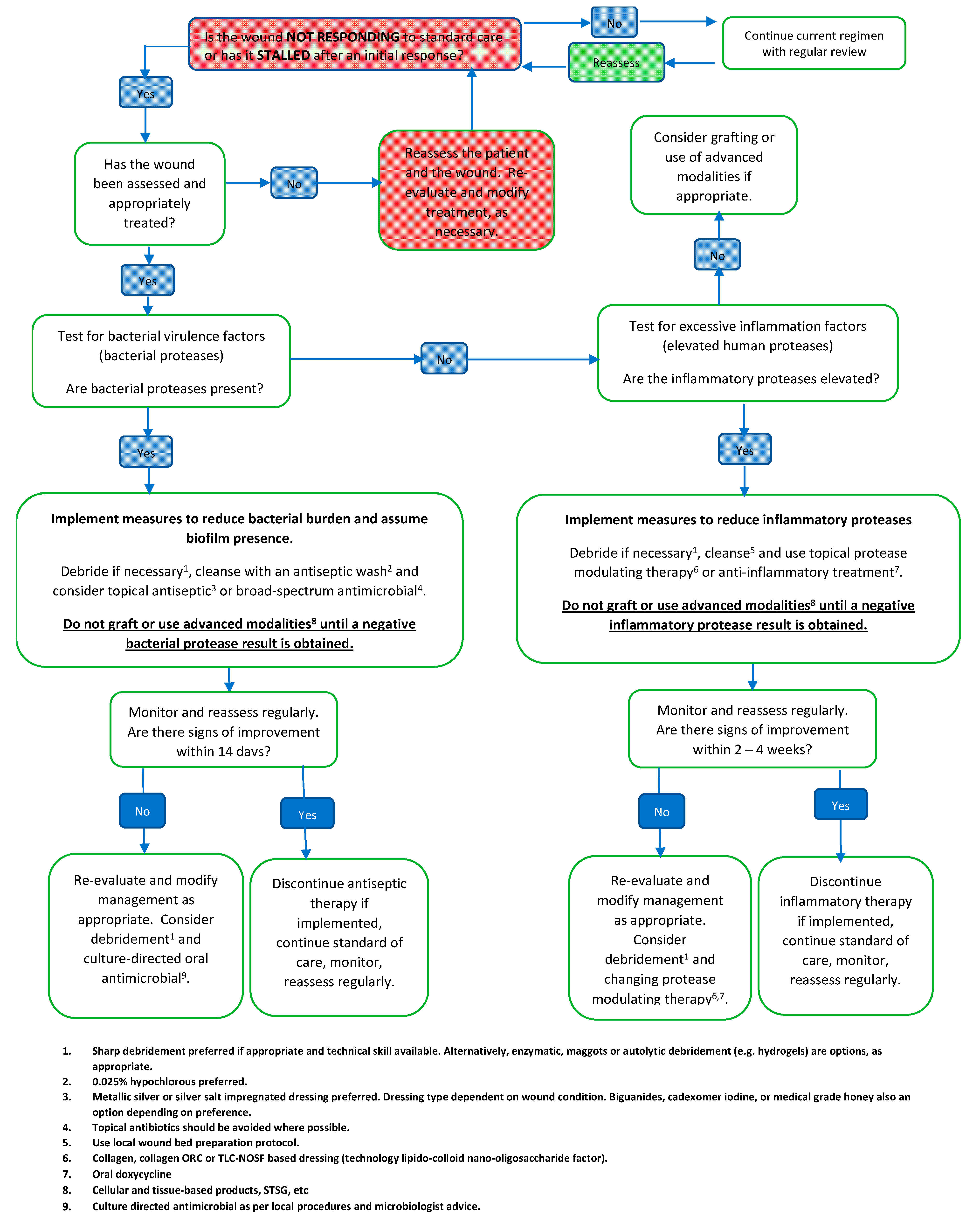Principles of Best Diagnostic Practice in Tissue Repair and Wound Healing: An Expert Consensus
Abstract
1. Introduction
2. The Technology
2.1. Excessive Inflammatory Protease Activity (EPA)
2.2. Bacterial Protease Activity (BPA)
3. Methods
- determine the cause of the wound;
- identify any comorbidities/complications that may contribute to the wound or delay healing;
- assess the status of the wound;
- help to develop the management plan.
4. Panel Recommendations
4.1. Question 1: Which Test Should I Use First, BPA or EPA?
4.2. Question 2: What Is the Best Therapy Pathway Once I Get the Test Results?
4.3. Question 3: When Should I Retest?
5. Summary of Therapy Pathway the Table Outlines a Plan of Care Based on the Results of the BPA and EPA Results
| EPA Elevated | EPA Not Evevated | |
| BPA Elevated |
|
|
| BPA Not Elevated |
|
|
6. Additional Considerations
6.1. Wound Bed Preparation Prior to Advanced Therapies
6.2. Antimicrobial Stewardship
7. Conclusions
Funding
Conflicts of Interest
References
- Nussbaum, S.R.; Carter, M.J.; Fife, C.E.; DaVanzo, J.; Haught, R.; Nusgart, M.; Cartwright, D. An Economic Evaluation of the Impact, Cost, and Medicare Policy Implications of Chronic Nonhealing Wounds. Value Health 2018, 21, 27–32. [Google Scholar] [CrossRef] [PubMed]
- Sen, C.K. Human Wounds and Its Burden: An Updated Compendium of Estimates. Adv. Wound Care 2019, 8, 39–48. [Google Scholar] [CrossRef] [PubMed]
- Fife, C.E.; Carter, M.J. Wound Care Outcomes and Associated Cost among Patients Treated in US Outpatient Wound Centers: Data from the US Wound Registry. Wounds 2012, 24, 10–17. [Google Scholar] [PubMed]
- Ousey, K.; McIntosh, C. Understanding wound bed preparation and wound debridement. Br. J. Community Nurs. 2010, 15, S22–S28. [Google Scholar] [CrossRef] [PubMed]
- Armstrong, D.G. The future of diabetic foot and wound assessment: Stick and rudder visual cues or instrument-rated? Diabet. Foot J. 2018, 21, 1–3. [Google Scholar]
- Fisher, T.K.; Wolcott, R.; Wolk, D.M.; Bharara, M.; Kimbriel, H.R.; Armstrong, D.G. Diabetic Foot Infections: A Need for Innovative Assessments. Int. J. Low Extrem. Wounds 2010, 9, 31–36. [Google Scholar] [CrossRef] [PubMed]
- Armstrong, D.G.; Giovinco, N.A. Diagnostics, Theragnostics, and the Personal Health Server. Foot Ankle Spéc. 2011, 4, 54–60. [Google Scholar] [CrossRef] [PubMed]
- Armstrong, D.G.; Lew, E.J.; Hurwitz, B.; Wild, T. The quest for tissue repair’s holy grail: The promise of wound diagnostics or just another fishing expedition? Wound Med. 2015, 8, 1–5. Available online: http://www.sciencedirect.com/science/article/pii/S2213909515000130 (accessed on 24 November 2020). [CrossRef]
- Serena, T.E.; Hanft, J.; Synder, R. The Lack of Reliability of Clinical Examination in the Diagnosis of Wound Infection: Analysis of a Venous Leg Ulcer Clinical Trial. Int. J. Low Extrem. Wounds 2008, 7, 32–35. [Google Scholar] [CrossRef] [PubMed]
- Le, L.; Baer, M.; Briggs, P.; Bullock, N.; Cole, W.; DiMarco, D.; Hamil, R.; Harrell, K.; Kasper, M.; Li, W.; et al. Diagnostic Accuracy of Point-of-Care Fluorescence Imaging for the Detection of Bacterial Burden in Wounds: Results from the 350-Patient FLAAG Trial. Adv. Wound Care 2020. [Google Scholar] [CrossRef] [PubMed]
- Serena, T.E.; Cullen, B.M.; Bayliff, S.W.; Gibson, M.C.; Carter, M.J.; Chen, L.; Yaakov, R.A.; Samies, J.; Sabo, M.; Demarco, D.; et al. Defining a new diagnostic assessment parameter for wound care: Elevated protease activity, an indicator of nonhealing, for targeted protease-modulating treatment. Wound Repair Regen. 2016, 24, 589–595. [Google Scholar] [CrossRef] [PubMed]
- Läuchli, S.; Swanson, T.; Serena, T.; Harding, K. The use of a point-of-care test for bacterial protease activity in chronic wounds. Wounds Int. 2015, 6, 22–28. [Google Scholar]
- Weighted avg. of Serena 2011, Ivory Wounds UK Harrogate, UK. 2013, Duteille European Wound Management Association Copenhagen DA 2013, Anichini European Wound Management Association Copenhagen DA 2013, Uccioli, and Serena Symposium for Advanced Wound Care Las Vegas NV 2015 available from Woundchek Labs’ data library.
- Duteille, F. Evaluation of the Use of a Point of Care Test for Proteases to Identify Patients with Increased Risk of Skin Graft Failure; European Wound Management Association: Copenhagen, Denmark, 2013. [Google Scholar]
- Izzo, V.; Meloni, M.; Vainieri, E.; Giurato, L.; Ruotolo, V.; Uccioli, L. High matrix metalloprotease levels are associated with dermal graft failure in diabetic foot ulcers. Int. J. Low. Extrem. Wounds 2014, 13, 191–196. [Google Scholar] [CrossRef] [PubMed]
- World Union of Wound Healing Societies (WUWHS). Principles of Best Practice: Diagnostics and Wounds; A Consensus Document; MEP Ltd.: London, UK, 2008. [Google Scholar]
- Dissemond, J.; Schultz, G.; Serena, T. EPA Made Easy; Wounds International: London, UK, 2013. [Google Scholar]
- Serena, T.; Chadwick, P.; Duteille, F.; Romanelli, M.; Lauchli, S.; Martinez, J. BPA Made Easy; Wounds International: London, UK, 2016. [Google Scholar]
- Serena, T.E.; Bayliff, S.W.; Brosnan, P.J.; DiMarco, D.T.; Doner, B.A.; Guthrie, D.A.; Patel, K.D.; Sabo, M.J.; Samies, J.H.; Carter, M.J. Bacterial protease activity as a biomarker to assess the risk of non-healing in chronic wounds: Results from a multicenter randomized controlled clinical trial. 2021; in press. [Google Scholar]
- Joint Commission. R3 Report/Requirement, Rational, Reference. Issue 23, 20 June 2019. Available online: https://www.jointcommission.org/standards/r3-report/r3-report-issue-23-antimicrobial-stewardship-in-ambulatory-health-care/ (accessed on 15 June 2020).


Publisher’s Note: MDPI stays neutral with regard to jurisdictional claims in published maps and institutional affiliations. |
© 2020 by the authors. Licensee MDPI, Basel, Switzerland. This article is an open access article distributed under the terms and conditions of the Creative Commons Attribution (CC BY) license (http://creativecommons.org/licenses/by/4.0/).
Share and Cite
G. Armstrong, D.; Bauer, K.; Bohn, G.; Carter, M.; Snyder, R.; Serena, T.E. Principles of Best Diagnostic Practice in Tissue Repair and Wound Healing: An Expert Consensus. Diagnostics 2021, 11, 50. https://doi.org/10.3390/diagnostics11010050
G. Armstrong D, Bauer K, Bohn G, Carter M, Snyder R, Serena TE. Principles of Best Diagnostic Practice in Tissue Repair and Wound Healing: An Expert Consensus. Diagnostics. 2021; 11(1):50. https://doi.org/10.3390/diagnostics11010050
Chicago/Turabian StyleG. Armstrong, David, Karen Bauer, Greg Bohn, Marissa Carter, Robert Snyder, and Thomas E. Serena. 2021. "Principles of Best Diagnostic Practice in Tissue Repair and Wound Healing: An Expert Consensus" Diagnostics 11, no. 1: 50. https://doi.org/10.3390/diagnostics11010050
APA StyleG. Armstrong, D., Bauer, K., Bohn, G., Carter, M., Snyder, R., & Serena, T. E. (2021). Principles of Best Diagnostic Practice in Tissue Repair and Wound Healing: An Expert Consensus. Diagnostics, 11(1), 50. https://doi.org/10.3390/diagnostics11010050







